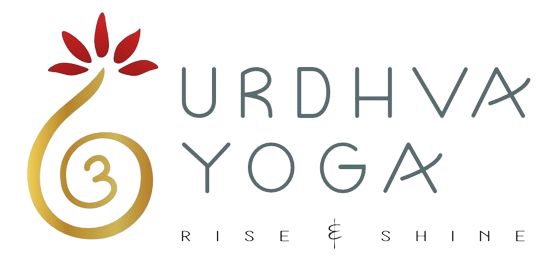
Yoga is most associated with its most visible aspect of asanas, which has become synonymous with Yoga. In its true essence, Yoga is the means to realize our true nature, finding which one abides in eternal peace and bliss.
Yoga is a life science that gives us a complete road map to work with ourselves. All the methods and tools of Yoga are available for each of us to work with, thereby healing ourselves and lead a fuller life.
This aspect of Yoga is at the core of our inspiration to share yogic practices. Urdhva in Sanskrit means upward rising, elevating. The philosophy and practices of Yoga and Vedic knowledge are means to raise our physical health, emotions, and consciousness to a higher and purer level.
Yoga is a life science that gives us a complete road map to work with ourselves. All the methods and tools of Yoga are available for each of us to work with, thereby healing ourselves and lead a fuller life.
This aspect of Yoga is at the core of our inspiration to share yogic practices. Urdhva in Sanskrit means upward rising, elevating. The philosophy and practices of Yoga and Vedic knowledge are means to raise our physical health, emotions, and consciousness to a higher and purer level.
The holy Bhagavad Gita says,
ūrdhvaṁ gachchhanti sattva-sthā madhye tiṣhṭhanti rājasāḥ
jaghanya-guṇa-vṛitti-sthā adho gachchhanti tāmasāḥ
Those situated in the mode of goodness rise upward; those in the mode of passion stay in the middle; and those in the mode of ignorance go downward.
Bhagavad Gita 14.18
jaghanya-guṇa-vṛitti-sthā adho gachchhanti tāmasāḥ
Those situated in the mode of goodness rise upward; those in the mode of passion stay in the middle; and those in the mode of ignorance go downward.
Bhagavad Gita 14.18
The foundation of Yoga is rooted in Sankhya philosophy, which provides a framework for understanding the nature of existence and the process of evolution and involution. According to Sankhya philosophy, the universe is composed of two fundamental entities: Purusha (consciousness) and Prakriti (primordial matter). Prakriti consists of three gunas (qualities) – sattva (purity, harmony), rajas (activity, passion), and tamas (inertia, darkness).
These gunas are present in everything, including our body and mind. The interactions and fluctuations of these gunas give rise to different combinations, leading to modifications in our physical and mental states. Sattva represents balance, clarity, and tranquility, rajas represents activity and restlessness, and tamas represents inertia and heaviness.
In the practice of Yoga, the aim is to bring about a harmonious balance among the gunas and elements within ourselves. Through various yogic practices, such as yamas, niyamas, asanas, pranayama, and meditation, we can cultivate sattva, reducing the influence of rajas and tamas. This process helps to purify and refine the body and mind, allowing us to experience greater clarity, peace, and spiritual growth.
These gunas are present in everything, including our body and mind. The interactions and fluctuations of these gunas give rise to different combinations, leading to modifications in our physical and mental states. Sattva represents balance, clarity, and tranquility, rajas represents activity and restlessness, and tamas represents inertia and heaviness.
In the practice of Yoga, the aim is to bring about a harmonious balance among the gunas and elements within ourselves. Through various yogic practices, such as yamas, niyamas, asanas, pranayama, and meditation, we can cultivate sattva, reducing the influence of rajas and tamas. This process helps to purify and refine the body and mind, allowing us to experience greater clarity, peace, and spiritual growth.
“Yoga is a journey of the self, through the self to the Self.”
~ Swami Veda Bharati
Where do we begin from?
Self-Healing
The system of Ashtanga Yoga of Pātañjali, is an eight-limb system beginning from yamas-niyamas to the ultimate goal of samadhi. Physical postures called asana in Yoga are preparatory to higher practices of Yoga. Yet, asana or hatha Yoga practice is a powerful way to connect with ourselves starting from the physical level. Sthira-sukham-asanam – a posture is that – in which our joy flows steadily. Forcing, tensing, overdoing, and competing in asanas is not Yoga. Yoga leads us to steadiness in any situation, to rise from wherever we are to our ultimate, true Self.
The way of self-healing in a yogic way is to lead a conscious life, with attitudes of ahimsa (non-violence), satya (truthfulness), asteya (non-stealing), brahmacharya (restraint), aparigraha (non-possessiveness). And self-discipline through practices of shaucha (cleanliness), santosha (contentment), tapas (endurance), swadhyaya (study of self through yogic texts), ishwar-pranidhana (surrender to God).
Ayurvedic lifestyle helps with regulating our day-to-day functioning and grants a long and healthy life so one may pursue the higher goal of life through Yoga. Through practices of dincharya and ritucharya we learn to live in harmony with nature, this brings in healing and health through improved digestive fire, waste elimination, proper functioning of dhatus (tissues), calmness, and clarity of mind.
The way of self-healing in a yogic way is to lead a conscious life, with attitudes of ahimsa (non-violence), satya (truthfulness), asteya (non-stealing), brahmacharya (restraint), aparigraha (non-possessiveness). And self-discipline through practices of shaucha (cleanliness), santosha (contentment), tapas (endurance), swadhyaya (study of self through yogic texts), ishwar-pranidhana (surrender to God).
Ayurvedic lifestyle helps with regulating our day-to-day functioning and grants a long and healthy life so one may pursue the higher goal of life through Yoga. Through practices of dincharya and ritucharya we learn to live in harmony with nature, this brings in healing and health through improved digestive fire, waste elimination, proper functioning of dhatus (tissues), calmness, and clarity of mind.
Working on ourselves
Self-Transformation
Yogic texts declare:
Bhumau patati pādānam bhumirev paraṃ valam
Raise yourself from the very ground on which you have fallen.
Simply put, Yoga begins from where you are. If we think of ourselves as a body, or as a young or an old person, a sickly or healthy person, our work begins from there. Begin from whichever point you are.
Yoga philosophy helps us to understand the nature and functioning of our mind, understanding it and working to make it clear, calm, and joyful. The holy Bhagavad Gita is also called Yoga Shastra, a yogic scripture; it describes Yoga as samatvam, meaning equanimity. All life has inherent qualities of complementary opposites, such as day-night, heat-cold, pleasant-unpleasant, and so on. Yoga philosophy aids in inner transformation so our mind can remain balanced through experiences of gain and loss, good and bad, honor and dishonor, and we learn to stay calm even in a storm. This is the way of “samatvam yog-ucchyate”, Yoga is equanimity in the polarities of the world and its experiences.
As we begin to practice these principles, we feel the rise within us of lightness, purity, and clarity and that is when we know we are moving towards sattva, rising toward our true Self.
Bhumau patati pādānam bhumirev paraṃ valam
Raise yourself from the very ground on which you have fallen.
Simply put, Yoga begins from where you are. If we think of ourselves as a body, or as a young or an old person, a sickly or healthy person, our work begins from there. Begin from whichever point you are.
Yoga philosophy helps us to understand the nature and functioning of our mind, understanding it and working to make it clear, calm, and joyful. The holy Bhagavad Gita is also called Yoga Shastra, a yogic scripture; it describes Yoga as samatvam, meaning equanimity. All life has inherent qualities of complementary opposites, such as day-night, heat-cold, pleasant-unpleasant, and so on. Yoga philosophy aids in inner transformation so our mind can remain balanced through experiences of gain and loss, good and bad, honor and dishonor, and we learn to stay calm even in a storm. This is the way of “samatvam yog-ucchyate”, Yoga is equanimity in the polarities of the world and its experiences.
As we begin to practice these principles, we feel the rise within us of lightness, purity, and clarity and that is when we know we are moving towards sattva, rising toward our true Self.












